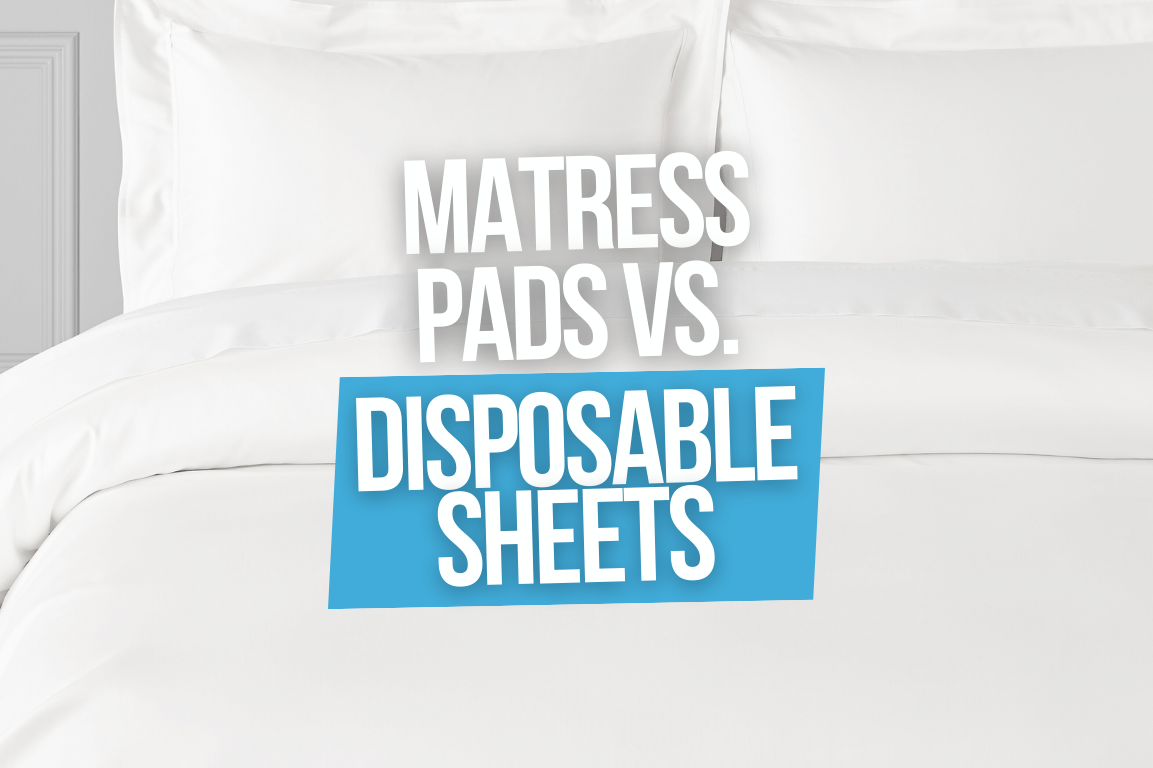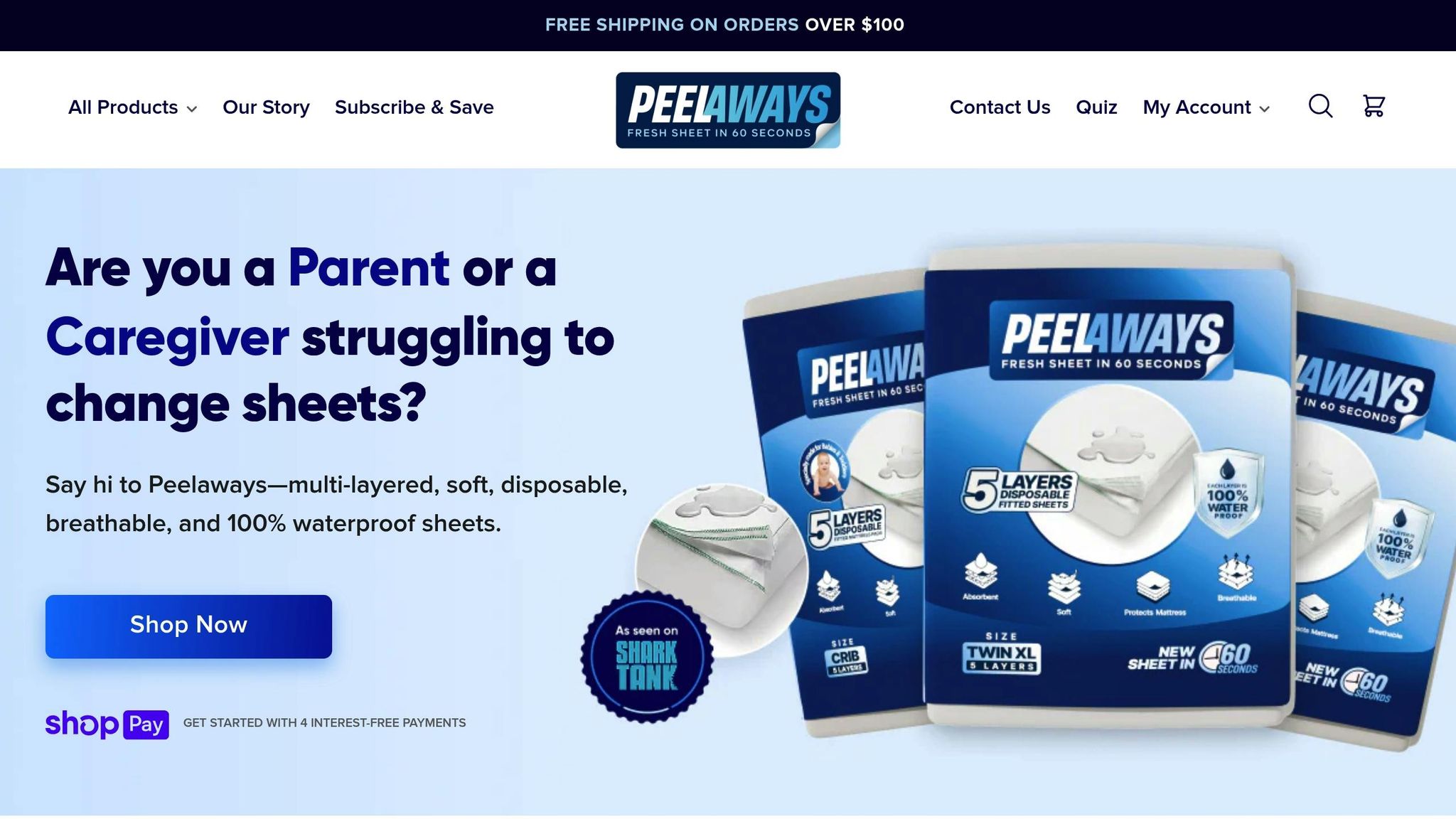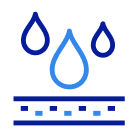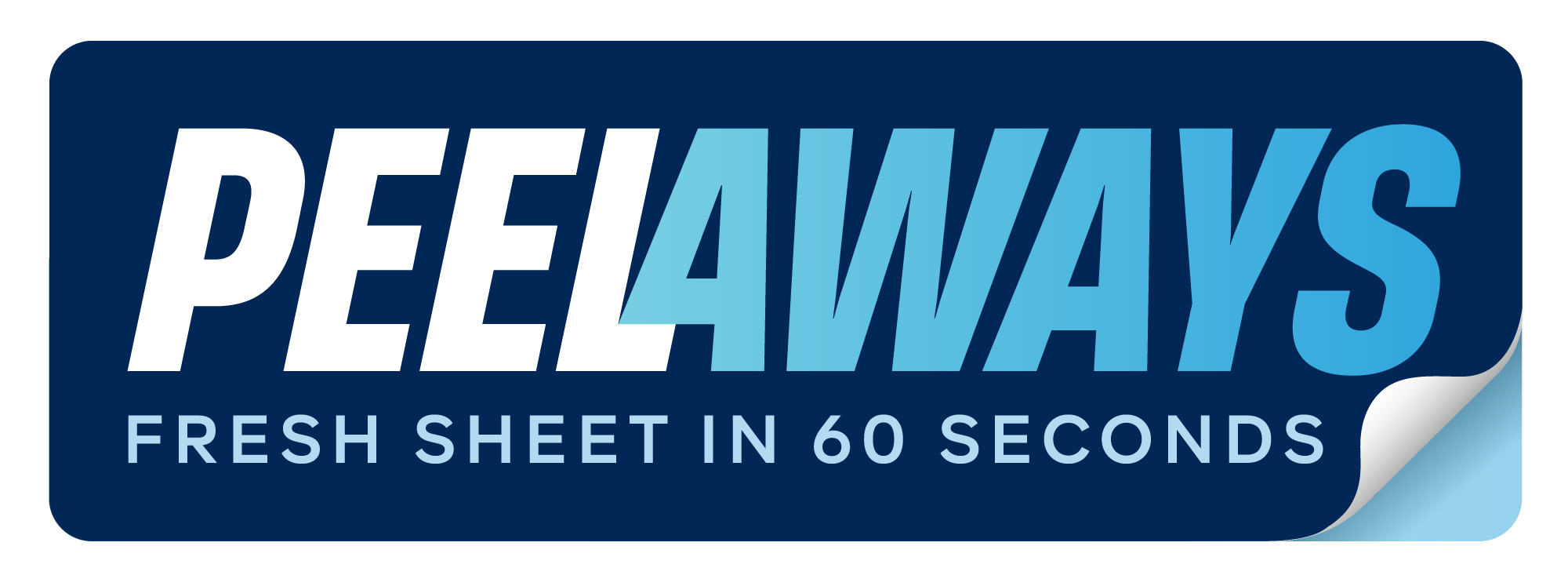Waterproof Mattress Pads vs. Disposable Sheets

When it comes to managing bedwetting or incontinence, you have two main options: waterproof mattress pads and disposable sheets. Each serves the same purpose - protecting your mattress - but they differ in cost, maintenance, and convenience. Here's a quick breakdown:
- Waterproof Mattress Pads: Reusable, sit under regular sheets, and require washing after use. They are cost-effective over time but involve more upkeep.
- Disposable Sheets: Single-use or multi-layered sheets (e.g., PeelAways) allow for quick cleanup without laundry. They're highly convenient but come with recurring costs and waste concerns.
Which is better? It depends on your needs. Mattress pads are ideal for long-term use and eco-conscious buyers, while disposable sheets are perfect for frequent accidents, travel, or situations where hygiene is critical.
Quick Comparison
| Factor | Waterproof Mattress Pads | Disposable Sheets |
|---|---|---|
| Initial Cost | $25–$75 (one-time) | $30.99–$53.99 per pack |
| Long-term Cost | Lower (lasts 2–5 years) | Higher (recurring expenses) |
| Convenience | Requires washing and drying | No laundry, just toss or peel |
| Hygiene | Higher cross-contamination risk | Single-use, low contamination |
| Comfort | Soft fabric feel | May shift, less plush |
| Eco-friendliness | Reusable, less waste | Generates waste, some biodegradable options available |
Both options can work together: use waterproof pads for everyday needs and disposable sheets for travel or emergencies.
Waterproof Mattress Pads
What Are Waterproof Mattress Pads?
Waterproof mattress pads are designed with a layer of polyurethane, vinyl, or TPU that blocks moisture, paired with absorbent materials like cotton terry, bamboo, or polyester blends. These pads sit beneath your sheets, creating a shield to protect your mattress from spills or accidents. Some models go a step further by including extra absorbent layers for added protection.
To stay securely in place, most pads come with fitted corners or fasteners, and they’re available in various sizes to fit different mattresses. This thoughtful design ensures they not only manage moisture effectively but also help extend the life of your mattress.
Benefits of Waterproof Mattress Pads
These pads offer a practical way to protect your mattress over the long term by guarding against spills and accidents. Since they’re reusable, they can save money over time and are a more eco-friendly option compared to disposable products. Beyond liquid protection, they can also act as a barrier against dust mites and allergens, helping to maintain a cleaner and healthier sleeping space.
Drawbacks of Waterproof Mattress Pads
One downside is the upkeep. After an accident, you’ll need to remove the pad, wash it, dry it, and put it back on the bed, which can be a hassle. This process might be especially challenging for those with limited mobility or caregivers managing multiple beds.
Some pads may also have drawbacks like being noisy or retaining heat, which could interfere with sleep comfort. Additionally, high-quality pads can be pricey upfront, and if you need multiple pads or backups, the cost can add up quickly.
Disposable Sheets
What Are Disposable Sheets?
Disposable sheets are a practical, single-use bedding option designed with a waterproof backing and an absorbent top layer, eliminating the need for washing. Most come in a fitted sheet style with elastic edges to securely fit the mattress.
PeelAways takes this concept further with its patented 5- to 7-layer design. Instead of replacing the entire sheet, you simply peel away the soiled top layer to reveal a fresh, clean surface underneath. This clever setup provides multiple uses from a single product, making it a convenient solution for managing accidents.
Benefits of Disposable Sheets
Disposable sheets come with a range of benefits that make them a go-to option for many situations:
- No laundry required: One of their biggest perks is the complete elimination of washing. After an accident, you can simply remove and discard the sheet, skipping the hassle of cleaning, drying, and waiting for fresh bedding. This is a game-changer for caregivers handling multiple patients or families dealing with frequent nighttime messes.
- Hygienic and safe: Since each layer is single-use, there’s no risk of cross-contamination from washing soiled linens. Every use starts with a fresh, sterile surface, making these sheets especially popular in healthcare settings and elder care facilities.
- Travel-friendly: Lightweight and compact, disposable sheets are perfect for trips or emergencies when laundry facilities aren’t accessible. They’re also a time-saver for caregivers, cutting cleanup time to just a few minutes compared to the 30-45 minutes it takes to change and wash traditional bedding.
- Quick absorption: High-quality disposable sheets, like PeelAways, are designed to absorb liquids instantly, helping to prevent mattress damage and odors. They’re both waterproof and breathable, balancing protection with comfort.
Drawbacks of Disposable Sheets
While these sheets offer convenience, they’re not without their challenges:
- Ongoing expenses: Unlike a reusable waterproof mattress pad, disposable sheets require constant replenishment. For families managing nightly accidents, the costs can add up - ranging from $200 to $400 annually, depending on usage.
- Environmental concerns: Single-use products inevitably generate waste. However, options like PeelAways are addressing this issue by offering biodegradable and compostable materials to lessen their environmental footprint.
- Comfort and fit issues: Some disposable sheets may shift during the night, which can disrupt sleep. They may also lack the plush feel of traditional fabric mattress pads.
- Storage demands: Stocking up on disposable sheets to save money often means dedicating extra storage space. For those with limited closet room, this can be inconvenient.
- Always needing backups: The single-use nature of these sheets means you must keep replacements on hand at all times. Running out during an unexpected accident can add unnecessary stress to an already challenging situation.
Key Comparison: Waterproof Mattress Pads vs. Disposable Sheets
Comparison Table
Here's a quick side-by-side look to highlight the key differences:
| Factor | Waterproof Mattress Pads | Disposable Sheets (PeelAways pricing) |
|---|---|---|
| Initial Cost | $25–$75 one-time purchase | $30.99–$53.99 per pack |
| Long-term Cost | More affordable over time – lasts 2–5 years | Higher recurring costs due to regular replacement |
| Convenience | Needs washing, drying, and changing | No laundry – just peel away or toss when soiled |
| Setup Time | 5–10 minutes to change the bed | About 30 seconds to remove a used layer |
| Absorbency | Moderate – may need extra protection | High – absorbs liquids instantly |
| Comfort | Soft, fabric-like feel similar to regular bedding | Less plush, with possible shifting |
| Environmental Impact | Reusable and eco-friendly | Creates waste, though biodegradable options are available |
| Portability | Bulky for travel | Lightweight and easy to pack |
| Cross-contamination Risk | Higher – requires proper cleaning | Low risk with single-use layers |
| Storage Requirements | Minimal – one spare pad is enough | Requires space for multiple packs |
Choosing the Right Option for Your Needs
When deciding between waterproof mattress pads and disposable sheets, your choice will depend on your specific needs and lifestyle. For families dealing with occasional accidents, a quality waterproof mattress pad is a budget-friendly option. A single pad, priced around $50, can last several years, making it a solid long-term investment. On the other hand, disposable sheets, priced between $30.99 and $53.99 per pack, come with recurring costs but offer unmatched convenience.
For caregivers or families handling frequent nighttime accidents, disposable sheets are a lifesaver. They allow for quick cleanups, making them ideal for busy households or healthcare settings.
Environmental impact is another factor to weigh. If sustainability is a priority, reusable waterproof pads are the greener choice. However, disposable sheets do produce waste, though brands like PeelAways offer biodegradable options to reduce their footprint.
Travelers may lean toward disposable sheets for their lightweight design and the convenience of avoiding laundry while on the move. Waterproof mattress pads, while effective, can be bulkier to pack.
When it comes to comfort, waterproof mattress pads deliver a soft, fabric-like feel, similar to traditional bedding. In contrast, PeelAways' multi-layer disposable sheets provide a smooth surface but might not feel as plush.
For settings where hygiene is critical - like medical facilities or homes caring for individuals with weakened immune systems - the single-use nature of disposable sheets minimizes cross-contamination risks, offering peace of mind.
Ultimately, the right choice depends on your priorities, whether it's cost, convenience, sustainability, or hygiene. This guide helps you weigh the options and find the best fit for your family or care environment.
sbb-itb-45288fe
Best Use Cases and Decision Factors
When to Choose Waterproof Mattress Pads
Waterproof mattress pads are a practical, long-term solution for families dealing with occasional bedwetting or pet accidents. They’re designed to withstand regular washing - typically every 1–2 months, or more often if needed - making them a durable and cost-effective option over time. These pads also provide a soft, fabric-like texture, which is especially beneficial for children who are sensitive to changes in bedding materials. However, replacing and maintaining these pads can be a bit labor-intensive, especially with designs like zip-up styles that may require extra effort during changes.
When to Choose Disposable Sheets
Disposable sheets shine in situations where convenience and hygiene take center stage. They’re perfect for travel, short-term care, or any scenario where laundry isn’t feasible, offering a quick and easy cleanup. Their single-use design ensures a fresh, clean surface every time, reducing the risk of cross-contamination. This makes them particularly valuable in medical settings or homes caring for individuals with weakened immune systems. They’re also a great option for temporary needs, such as post-surgery recovery, short-term illnesses, or potty training, providing flexibility without the commitment of ongoing maintenance.
Why PeelAways Stands Out

PeelAways takes disposable bedding to the next level by addressing both hygiene and ease-of-use challenges. Its patented multi-layer design eliminates the need for full sheet replacements, featuring 5 to 7 soft, absorbent layers that can be peeled away one at a time when soiled.
Available in a variety of sizes - from the Crib-A-Peel for toddlers to standard home sizes like Twin, Full, Queen, and King - PeelAways offers options for every need. Healthcare professionals and caregivers particularly appreciate the simplicity of the peel-away system, which eliminates the need for lifting mattresses or handling extensive laundry. This feature also reduces the risk of cross-contamination, making it especially useful in elder care, special needs environments, and during medical recovery.
PeelAways further stands out by using chemical-free materials and offering biodegradable options, addressing environmental concerns without sacrificing convenience. The company sweetens the deal with perks like gift cards, a 15% subscription discount, and a 30-day money-back guarantee. These features make PeelAways a smart addition to any care plan for incontinence or bedwetting, blending practicality with peace of mind.
Conclusion
Summary of Key Differences
Deciding between waterproof mattress pads and disposable sheets often comes down to how often you’ll use them, your budget, and your lifestyle. Waterproof mattress pads may cost more upfront, but they save money over time since they’re reusable and machine-washable. However, they do require regular care, like washing every 2–3 months and following specific care instructions to maintain their typical lifespan of 1–2 years. On the other hand, disposable sheets are all about convenience - no laundry needed. Just toss them after use. While they’re cheaper initially, frequent use can add up financially, and they generate more waste. The biggest difference lies in upkeep: waterproof pads need careful cleaning with warm water, mild detergent, and proper drying, while disposable sheets skip all that but come with ongoing costs and waste concerns. These differences highlight which option might work better for different care needs.
Final Recommendations
For frequent use - like regular bedwetting, elder care, or managing long-term medical conditions - washable waterproof mattress pads are both practical and cost-effective. They’re a solid choice for those looking to save in the long run.
For occasional needs, such as travel, short-term use, or infrequent accidents, disposable sheets shine with their convenience and hygiene. They’re especially handy during potty training, medical recovery, or when staying overnight away from home.
Many caregivers find that using both options together works best: washable pads for everyday home use and disposable sheets as a backup for specific situations.
If you’re looking for something that blends the benefits of both, PeelAways offers an intriguing alternative. Their patented multi-layer design addresses many of the limitations of traditional disposable bedding. With prices starting at $30.99 for Crib-A-Peel and going up to $53.99 for King size, along with perks like a 15% subscription discount and a 30-day money-back guarantee, PeelAways combines convenience with less waste and easier maintenance.
Ultimately, the right choice depends on your priorities - whether that’s saving money over time, minimizing upkeep, or enjoying hassle-free convenience.
FAQs
What should I consider when deciding between waterproof mattress pads and disposable sheets for incontinence or bedwetting?
When choosing between waterproof mattress pads and disposable sheets, it's important to weigh factors like cost, ease of use, comfort, and maintenance. Waterproof mattress pads can be reused, which makes them a more budget-friendly and environmentally conscious option over time. That said, they do require regular washing, which can add to your chore list.
On the other hand, disposable sheets - such as those offered by Peelaways - are all about convenience. They allow for quick, mess-free changes without the need for laundry, making them a practical choice for caregivers or situations where bedding needs to be swapped out frequently.
Comfort is another key consideration. Some waterproof materials may feel noisy or trap heat, which could disrupt sleep. Disposable sheets might offer a quieter and cooler alternative, depending on the brand.
In the end, the right option comes down to your personal needs, how often bedding changes are required, and how much time you're willing to spend on cleaning.
Are waterproof mattress pads more environmentally friendly than disposable sheets?
Waterproof mattress pads stand out as a more environmentally conscious choice because they’re reusable, cutting down on waste and conserving resources. With a washable pad, you can significantly reduce landfill contributions and avoid the need for frequent replacements.
On the other hand, disposable sheets, though convenient, tend to generate more waste since they’re designed for single use and need constant restocking. That said, products like Peelaways offer an interesting alternative. Their multi-layer, peel-away design provides a balance between convenience and waste reduction compared to traditional disposable options.
When is it useful to combine waterproof mattress pads with disposable sheets?
Combining a waterproof mattress pad with disposable sheets is a practical solution for situations where cleanliness and moisture control are crucial - think incontinence care, bedwetting, or recovering from surgery.
The waterproof mattress pad serves as a reliable shield, protecting the mattress from spills and stains over the long term. On top of that, disposable sheets offer added convenience. When a layer gets soiled, you can simply remove it to expose a fresh, clean surface - no need to lift the mattress or deal with extra laundry.
This setup works especially well for elder care, potty training, or post-surgery recovery. It helps reduce the risk of cross-contamination, saves valuable time, and maintains a clean, comfortable sleeping space.
Related Blog Posts
- 5 Best Bed Protection Methods for Potty Training
- Disposable vs. Washable Bed Sheets: Comparison
- Peelaways vs. Traditional Waterproof Sheets
- Ultimate Guide to Incontinence Bedding Disposal
Comments
0

SAVE MONEY & WATER
Professionals & Institutions save a fortune on labor/laundry.

SUPERIOR COMFORT
The first thing our customers notice is how soft our sheets are.

100% WATERPROOF
Each layer is 100% Waterproof, perfect for spills and accidents

SAVE TIME
Change the sheet in under 1 minute without stripping the bed.




Leave a comment